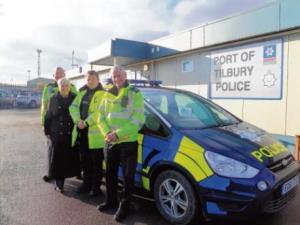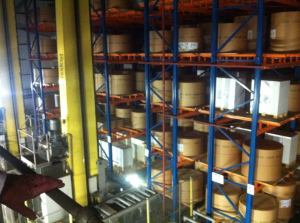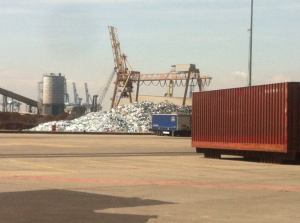Yet another advantage of studying at GMI is that we have two great ports within an hour’s drive of Greenwich. The further is the new London Gateway port, the largest container port in the UK, some 33 km downriver from Greenwich. The nearer, about 25 km downriver and forty minutes away across the Thames via the Blackwall or Dartford tunnels, is the historic port of Tilbury. Tilbury is still the third largest container port in the country but handles many other commodities, and is in many ways more interesting. London Gateway has only recently opened and getting a visit there is still difficult. But Tilbury is more varied, fascinating and a real eye-opener. On Friday 16 May, a beautiful clear sunny day, eleven staff and students headed for the port.
GMI Field Visit to Port of Tilbury, 16 May 2014. GMI students and staff : from left to right: Michael Olanipekun, Nigeria, MSc Maritime Security; Ian Robertson, UK, MA Maritime History; Pengfei Zhang, China, PhD candidate; Prof Chris Bellamy, UK, GMI Director; Gina Balta, Greece, PhD candidate; John Whiteley , UK, Business Faculty and GMI Visiting Lecturer; Eniola Ogundele, Nigeria, MA International Maritime Policy; Leo Balk, USA, MSc Maritime Security; Akash Raj, India, MSc Maritime Security; Ahmed Mohamed, Somalia, MA International Maritime Policy. Behind: standard shipping containers – the Twenty-foot Equivalent Unit (TEU)- what else?.
John Whiteley from the Business School, who teaches the Maritime Business Environment and Economics of International Shipping on our International Maritime Policy and Maritime Security programmes, organised the trip, re-establishing a link with Tilbury which had somehow become broken. Thanks to John and to Natalie Coonz, the Port of Tilbury training coordinator, the link has been re-established and GMI hopes to organise another visit, probably in the first term of the new academic year.
The objective of the visit was to see how a multi-faceted port handling diverse types of cargo operates and, in particular, to look at the implications of implementing the 2004 International Ship and Port facility Security (ISPS) Code.
Breaking down the large container loads at the port and having customers pick up smaller items from a distribution area at the port reduces distribution costs and saves fuel. Simon proudly said that Greenwich had been named the ‘greenest’ port in the UK. Chris Bellamy told him that was appropriate as Greenwich – the ‘greenest’ University in the UK!
An example of the savings made possible by port-centric logistics came from the Italian beer manufacturer Peroni. Peroni had traditionally brought their beers into Felixstowe. From there it was transported to a distribution centre in the Midlands. But the biggest market for trendy Peroni beer is – where? Answer – north London. So the beer was coming into Felixstowe, being unloaded en masse, transported to the Midlands and then the largest consignment headed for London. Peroni therefore shifted their operation to Tilbury, where the green bottles arrive quite close to their final destination – the bars of Islington, Hampstead and Highgate!
Simon was followed by the Port Facility Security Officer and Port Security Officer, Tony Catling. Tony had served as an officer in the Port of Tilbury London Police, which is an independent police force, one of 42 in England and Wales. It is also the second oldest true police force in the country. The first was the Marine Police, founded in 1798, which is now part of the Metropolitan Police into which it was incorporated in 1839. The Port of Tilbury London Police was founded in 1802, and remains an independent force with 15 officers. They have the same powers as regular constabulary, and a few more besides, and carry similar equipment.
Tony had been appointed to his present post immediately before implementation of aftermath of the introduction of the 2004 code, in order to help the Port adapt. The costs of implementing ISPS were considerable: an extra 30 port security officers (in addition to the Port police) from the outset and £4m-£5m per year, he said. This information chimed with Akash Raj’s research on the implementation of ISPS in India, where cost had been cited as a key problem. The port normally operates at State 1, where the whole site is broadly open to the public and only certain areas are secure. State 2 – heightened security alert – is the problem. Areas which are normally open for the traffic of goods have to be sealed off and extra port security officers brought in. State 3 – imminent attack on that particular location – is less of a problem. In that event, the port simply shuts down.
The standard of security Tilbury is well above the norm. Every container that comes in is scanned. The global norm is one percent. The security officers cannot open sealed containers but, if they are suspicious, the Port Police can. Similar rules affect people who enter restricted areas. A security officer can warn them not to, but if they do, only the police can drag them out. Tony noted that there are wide variations in the implementation of ISPS. In British ports, all restricted areas are sealed off with fencing to the required standard – BS 1722. Some countries just paint yellow lines with warning signs.
The team then headed for the Enterprise Distribution Centre (EDC) which specialises in handling paper from Storenzo, a Finnish company. The EDC is the most advanced and sophisticated computer controlled storage and distribution facility in the UK, and possibly in the world. Storenzo’s paper is used by News International for newspapers and by many book publishers. Appropriately dressed in high-visibility jackets and new dark blue ‘bump-hats’, which resembled those now worn by competitors in equestrian events, we salled into the vast computer-controlled facility, 30 metres high, and containing 29,000 huge rolls of different types of paper, weighing about a tonne each. When the rolls need to be loaded, the request is passed automatically through to the giant robot arms which select the paper from one of the 29,000 locations – which may be up to 30 metres in the air. James Smoker, the Operational Supervisor for the Enterprise Centre, said that the paper was imported and stored for News International and Inland Revenue and Customs, for tax returns, among others.
‘When 50 Shades of Grey won a prize’, James said, ‘we had twelve trucks a day – 52 reels each. We had the same when Harry Potter went big…’
The team then took a tour of the rest of the port. As the team toured the port, our guide pointed out the ship Radio Caroline, one of the pirate radio stations active just off the British coast in the early 1960s. The ship is no longer seaworthy but she is in safe keeping in Tilbury. In those days the BBC, funded through the licence fee, had a state monopoly on radio transmission. However, – before UNCLOS in 1982 – territorial waters still only stretched three miles – the range of an old cannon. A ship outside that distance was on the high seas, and could broadcast with impunity and be picked up across the UK. Radio Caroline had worked just off the Essex Coast. The pirate radio stations provided such stiff competition for the BBC that the Government had to give way. Many of the Disc Jockeys who had braved the elements and stormy seas on board the pirate radio ships were recruited by the BBC and joined the new Radio 1. This was useful information for the Maritime Policy and Security students, underlining the significance of territorial waters and EEZs.
Another specialised terminal is the grain terminal, shown below. Grain is brought in by sea, stored, and then distributed through pipes into trucks waiting at ground level.
This is another specialised facility, underlining the ‘port-centric’ concept.
The variety of goods flowing into and out of Tilbury is highlighted by the last photographs. The next two show standard TEUs, which can contain anything.
The last picture shows raw steel. Whether for import or export is unclear, as is its ultimate destination. Clearly a recycled product, and one of the products fuelling globalisation, especially the development of the burgeoning economies of China and India.
The team left at about 3 p.m. It was a relatively short but hugely important day, highlighting many aspects we had studied in the classroom: ISPS, Law of the Sea and territorial waters, and port-centric logistics, as well as underlining the enormous volume and variety of goods carried by sea. GMI will return!
Chris Bellamy
Director, Greenwich Maritime Institute









